The Parsi food culture is primarily a non-vegetarian one. Hence, I worked on a vegetarian version of one of their most popular recipes Dhansak, so that this rich and flavorful cuisine reaches one and all. This Dhansak recipe also features the Dhansak masala that gives this preparation that extra punch. It is a beautiful mélange of veggies and lentils, that you must try at home.
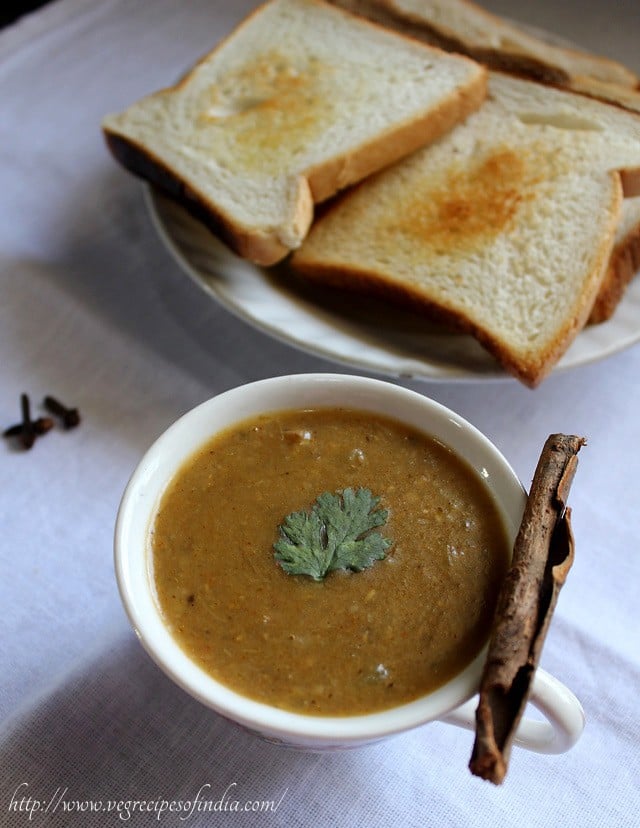
What is Dhansak
The Dhansak can be touted as the undefeated champion in Parsi comfort food. And why shouldn’t it be? I feel any dish that has the usage of lentils/legumes and vegetables in it, automatically becomes comforting and nourishing.
Along with which, the traditional Dhansak also has meat with liberal use of spices (read: Dhansak masala) and herbs. This iconic medley of veggies, lentils and spices may sound celebratory.
On the flip-side, the Dhansak is not really one and never becomes a part of weddings, festivals and celebrations according to the Parsi community. However, these days, it is one of the most cooked dishes in a weekend feast at many Parsi households.
Mostly, Dhansak is prepared or cooked on the fourth day of mourning after the demise of a near, dear and close one. Since the first three days are supposed to be meatless and vegetarian, a Dhansak that usually consists of meat, is made on the fourth day to break this particular restraint.
Also, according to some tales, the word Dhansak, when divided into two, is ‘dhan’ meaning a cereal based food in Gujarati and ‘sak’ from the ubiquitous Gujarati term ‘shaak’ meaning cooked greens or veggies.
Dhansak Masala
It will really be wrong on my part if I even think about the Dhansak, and not think of the Dhansak masala that makes it so amazing. Just like many other spice mixes, this masala mix is also a special one, especially in this Dhansak recipe.
Dhansak masala may look similar to Garam Masala but is actually not. My recipe of Dhansak masala may differ from what may be the original version, but most of the times it is this way.
This distinct masala recipe may differ from one Parsi household to other. Many also guard it as the family secret recipe.
Today, this Dhansak masala is available in almost all major cities pan India, and can also be sourced through online platforms.
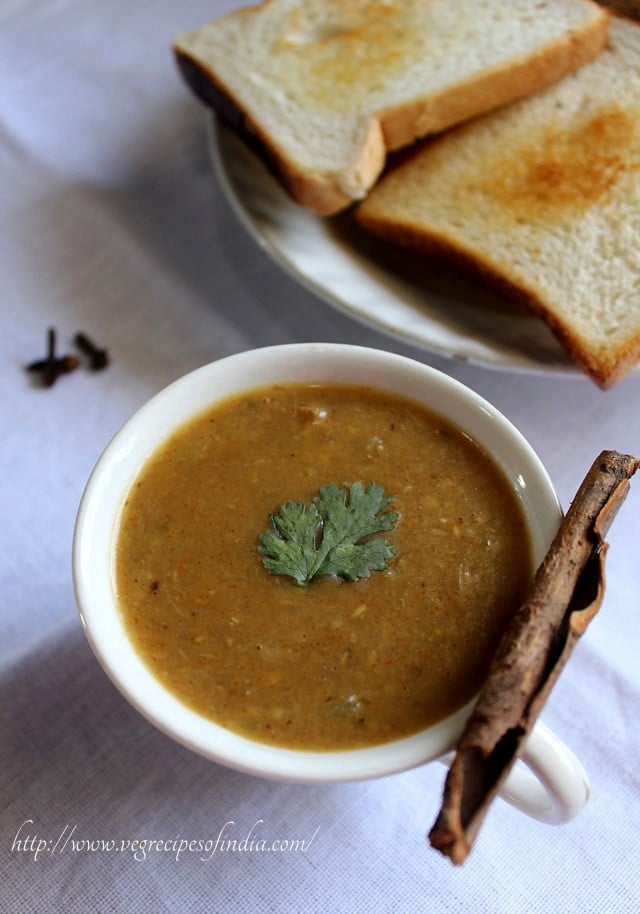
About Dhansak Recipe
The first time I had Dhansak was during my cooking school days and I must say I loved it at the first bite. So, it became quite mandatory for me to recreate an all-vegetarian Dhansak recipe since I am not a meat eater.
My association with Parsi cuisine was really minimal at that time. I had been to many Parsi weddings, but never really got to try any of their preparations as majorly all of it used to be non-vegetarian.
Most of my knowledge on this particular cuisine too was limited to Dhan Dar, Brown Rice, Patra ni Machchi and Lagan nu Custard. But I really couldn’t let go of the Dhansak as it had touched my taste buds so much.
Since I am a vegetarian, I worked on a Dhansak recipe with a house style Dhansak masala plus an array of lentils and vegetables. This recipe results in a warm, spicy, nutritious Dhansak packed with flavors.
I have added vegetables like bottle gourd or opo squash (lauki), potatoes, brinjal (eggplant/aubergine) and fenugreek leaves. Pumpkin also goes really well in it. The choice of lentils is tuvar dal, moong dal and masoor dal.
The best way to enjoy it is to serve it with a beautiful caramelized brown rice and a side of a fresh salad or Kachumber and lemon wedges. Traditionally, Parsi families may also prepare meat or prawn kababs and serve with it.
How to make Dhansak
Prepare lentils and vegetables
1. In a 4 to 5 litre pressure cooker, take the following veggies, lentils and herbs:
- 2 medium size chopped potatoes
- 1 cup chopped bottle gourd (opo squash, lauki)
- 2 to 3 medium-sized chopped eggplants, optional
- 1 cup chopped pumpkin
- 4 to 5 medium-sized chopped tomatoes
- 1 cup pigeon pea lentils (arhar dal, tuvar dal)
- ¼ cup green gram lentils (moong dal)
- ¼ cup pink lentils (masoor dal)
- 1 tablespoon dried fenugreek leaves (or 4 tablespoons fresh fenugreek leaves).
Add 4 cups water and pressure cook for 5 to 6 minutes on medium to medium-high heat. I added a few scallions too.
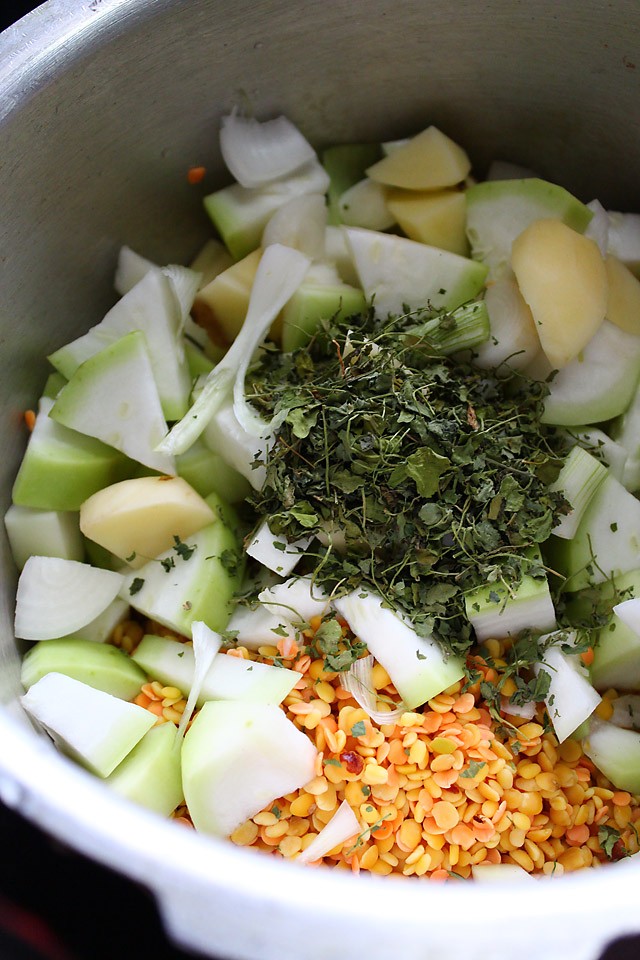
2. When the pressure drops naturally in the cooker, then only open the lid. Below is the picture of cooked vegetables and lentils. The lentils and vegetables should be really softened and mushy.
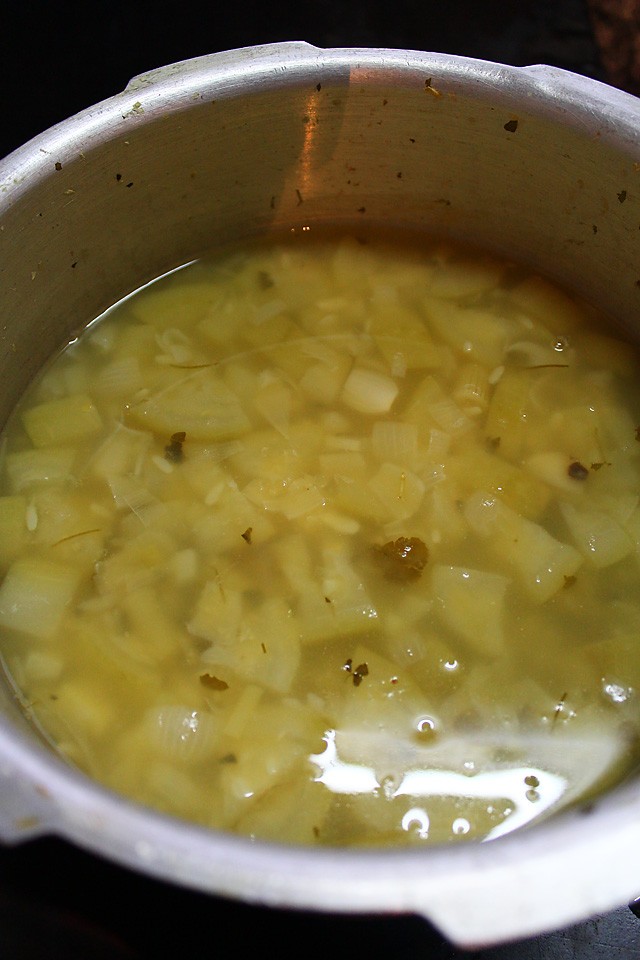
3. Now you could blend and mash the veggies and lentils together with the stock/cooked water, using a hand-held blender or an electric high-speed blender. If blending, make sure the mixture is not too hot. Let it become warm or cool and then blend.
I chose the conventional way of mashing the veggies, which you don’t have to do. Opt to blend the lentils and veggies using modern gadgets instead. You could also use a potato masher or a vegetable masher.
Through a strainer or a sieve pass the lentils and vegetables and mash with the back of a spoon while doing so.
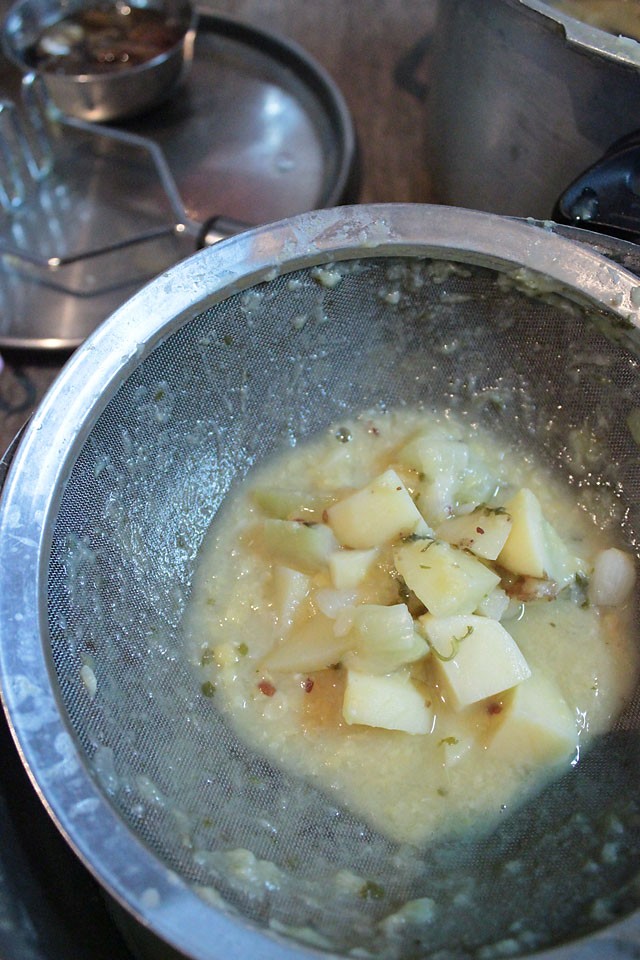
4. There should be no lumps at all. If using a fine strainer like the one I have, then the mashed vegetables won’t be able to pass through it.
So, mash them with a wooden spoon and then add it to the stock mixture (the water in which the vegetables and lentils were cooked).
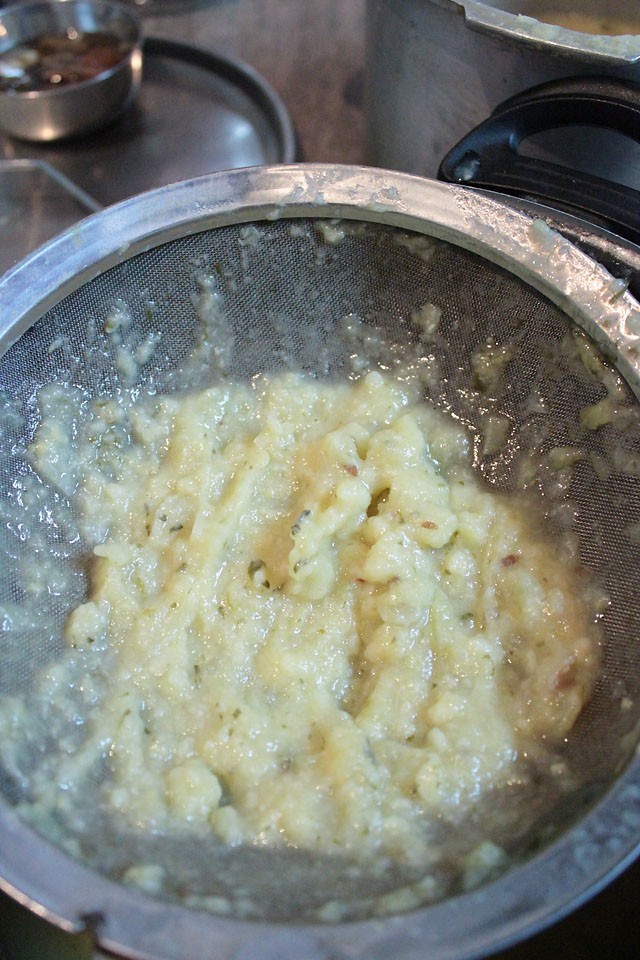
5. I went for a smooth mixture. But if you want, you can keep some chunky texture by not mashing the vegetables smoothly.
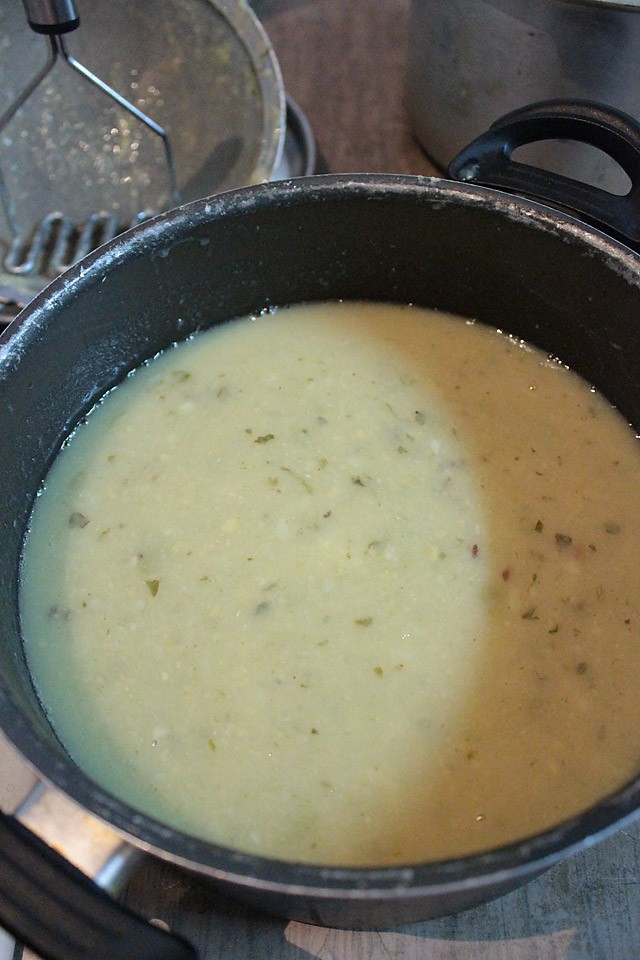
Prepare Dhansak masala
6. Below are the ingredients for the Dhansak masala:
- 12 garlic cloves (small to medium-sized)
- 1 inch ginger, peeled and roughly chopped
- 2 green chilies, roughly chopped
- 1 tablespoon coriander seeds
- 2 inches cinnamon stick
- 8 to 9 cloves
- ½ teaspoon cumin seeds
- ½ tablespoon red chili powder
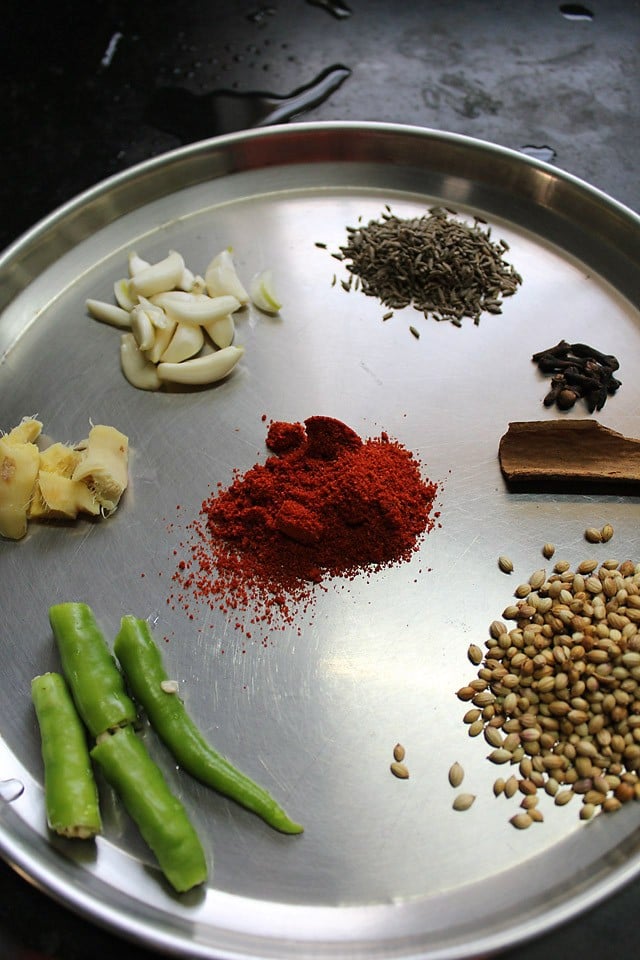
7. Take all these ingredients in a grinder, add some water and grind to a smooth paste. The freshness and aroma of this masala paste is wonderful.
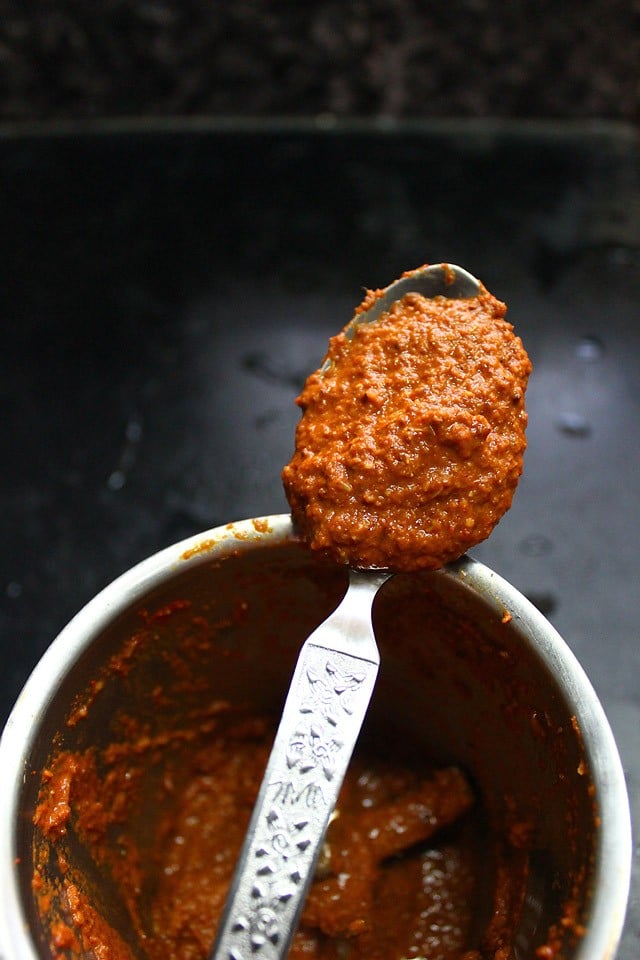
Make Dhansak
8. Now, heat 2 to 3 tablespoons ghee in the same pressure cooker or another pot or pan. Add 1 medium to large chopped onion (about ½ cup, chopped) and sauté until onions are softened.
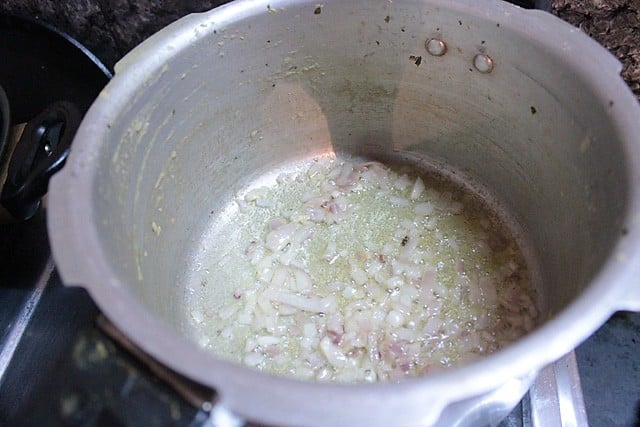
9. Add the prepared Dhansak masala and sauté stirring often till the raw aroma goes away. You should see the oil separating from the masala.
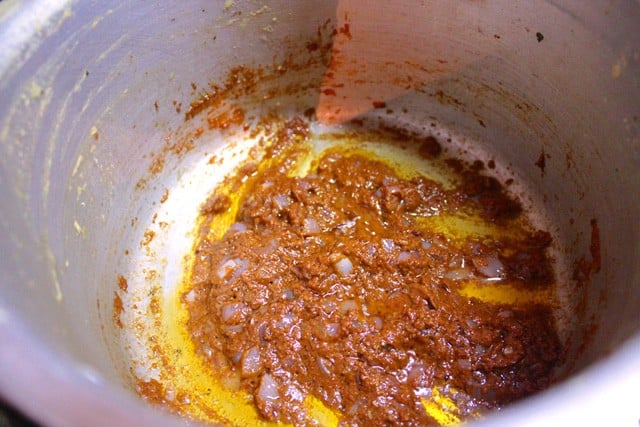
10. Add the mashed lentils-vegetable mixture to the cooker. Simmer for a few minutes.
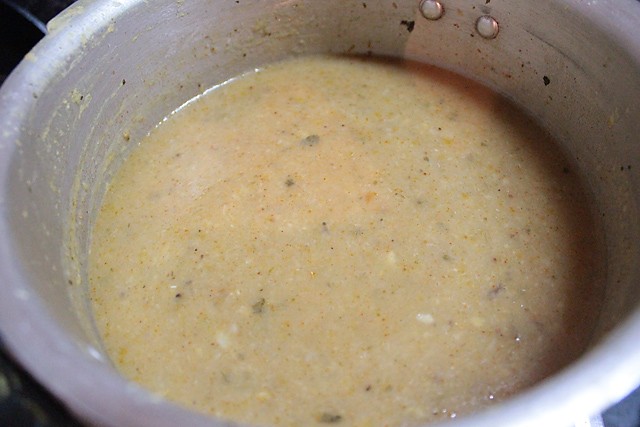
11. Finally, add 3 to 4 teaspoons tamarind pulp (or about ¼ teaspoon tamarind paste) and simmer for some more minutes until the raw flavor of tamarind goes away.
If you look very carefully you will see the dark tamarind pulp color almost off the center on the right hand side.
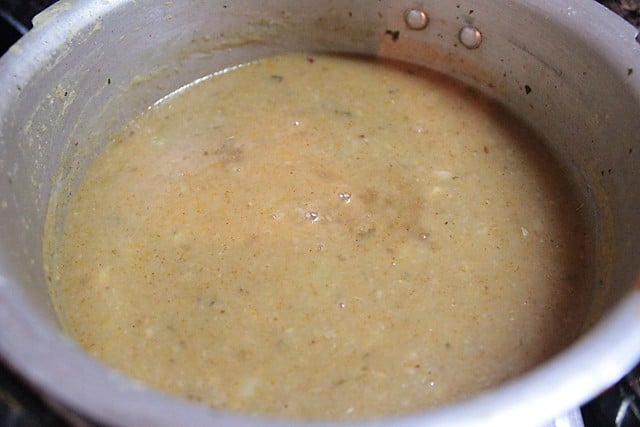
12. Serve the Veg Dhansak hot with Parsi Brown Rice or simple steamed Basmati Rice. You could also pair it with Vegetable Pulao, Ghee Rice or Jeera Rice.
You can also have it like a soup with some warm toasted bread or garlic bread. It tastes delightful with both rice and bread.
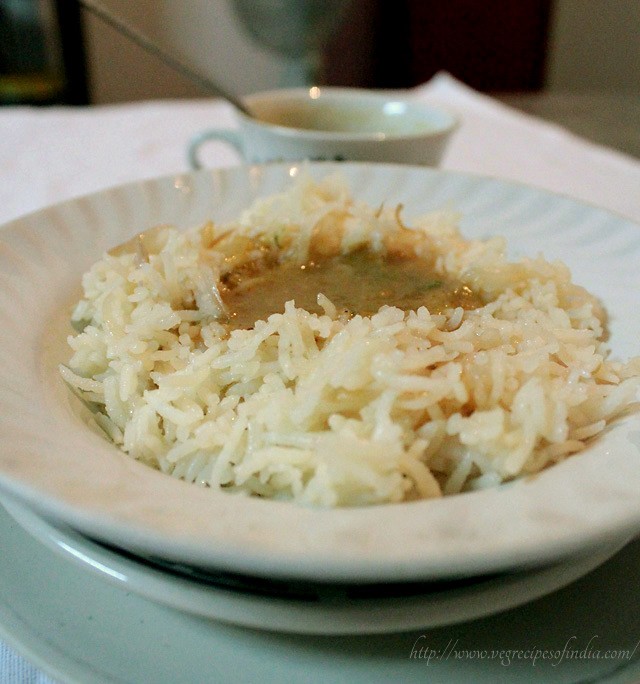
Expert Tips
- I strongly suggest the use of pumpkin in this Dhansak recipe. It gives a remarkable flavor. Other than this, for an authentic taste, go for aubergine and bottle gourd.
- Some of the traditional recipes use 5 types of lentils. I added 3, and you can settle for even just one type. Choose from either tuvar dal (pigeon pea lentils) or masoor dal (pink lentils). You can opt to use a mix of chana dal, tuvar dal, moong dal and masoor dal.
- Another major ingredient for Dhansak is fenugreek leaves (methi) – use either fresh or dried. While making it at home, I did not have fresh methi. So, I added dried fenugreek leaves also known as kasuri methi.
- You can serve it the way I’ve mentioned above. In case you don’t want to go the extra mile, have a bowl of this Dhansak all by itself. It is tasty, filling and hearty.
- You can even garnish the Dhansak with some browned or fried onions on top for an extra punch.
More Lentil Recipes To Try!
Dal (Lentils) & Legumes
Dal (Lentils) & Legumes
Dal (Lentils) & Legumes
Dal (Lentils) & Legumes
Please be sure to rate the recipe in the recipe card or leave a comment below if you have made it. For more vegetarian inspirations, Sign Up for my emails or follow me on Instagram, Youtube, Facebook, Pinterest or Twitter.
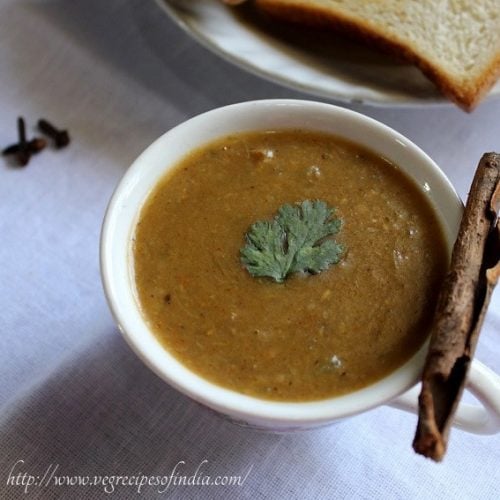
Dhansak Recipe
Ingredients
For cooking lentils and veggies
- 1 cup tuvar dal (arhar dal, tur dal or pigeon pea lentils)
- ¼ cup moong dal (hulled and split green gram lentils)
- ¼ cup masoor dal (hulled and split pink lentils)
- 4 to 5 tomatoes (medium-sized), chopped
- 2 potatoes (medium-sized), chopped
- 2 to 3 eggplant (medium-sized), baingan
- 1 cup pumpkin (peeled and chopped)
- 1 cup bottlegourd (peeled and chopped)
- 4 tablespoons fenugreek leaves (fresh) or 1 tablespoon dry fenugreek leaves (kasuri methi)
- 4 cups water
- salt to taste
More Ingredients
- 2 to 3 tablespoons Ghee
- 1 onion (medium to large), chopped or ½ cup, chopped
For tamarind pulp
- ½ tablespoon tamarind
- 2 to 3 tablespoons water – hot or warm
For the dhansak masala
- 12 garlic cloves (small to medium-sized)
- 1 inch ginger – peeled and roughly chopped
- 1.5 teaspoon cumin seeds
- 2 inches cinnamon stick
- 1 tablespoon coriander seeds
- 1 to 2 dry red chilies (seeds and stem removed) or ½ tablespoon red chili powder
- 8 to 9 cloves
- 2 green chilies
- water as needed, to grind the masala ingredients
Instructions
Preparing the lentils and veggies
- Pick and rinse the lentils first a few times in water.
- Mix all the chopped veggies, tomatoes and lentils together in a 4 to 5 litre stovetop pressure cooker.
- Add 4 cups water and pressure cook the lentils and veggies till they are tender and completely cooked.
- When the pressure falls naturally in the cooker, then only open the lid. Let this mixture become warm or cool.
- Then blend until fine using hand-held blender or in a high-speed blender or grinder.
- You could also strain the lentils and veggie mixture through a strainer and mash as you pass them through the strainer.
Making the tamarind pulp
- Take about ½ tablespoon of tamarind and soak it in 1 to 2 tablespoons of warm to hot water for 20 to 30 minutes.
- When the tamarind becomes soft, your pulp is almost ready. Squeeze the tamarind with your palm and extract the juices in the same bowl.
Preparing the dhansak masala
- Meanwhile when the veggies and lentils mixture is cooling, grind all the ingredients listed above, under the heading "For the dhansak masala" with some water to a fine and smooth paste.
- Keep the dhansak masala paste aside.
Making Dhansak
- Heat ghee in a pan or pot.
- Add chopped onions and sauté them till they soften.
- Add the ground dhansak masala paste and sauté it for 3 to 4 minutes or until the oil separates on low to medium-low heat.
- Now add the mashed lentils and veggie mixture.
- Simmer for a 5 to 6 minutes and then add the tamarind pulp.
- For a slightly thinner consistency, you can add some hot water.
- Simmer for some 5 minutes or more till the raw aroma and taste of the tamarind goes away.
- Serve the Veg Dhansak hot with brown rice or steamed basmati rice or even with veg pulao, jeera rice or ghee rice.
Notes
- Add veggies that you have in your kitchen, but do make sure to add pumpkin as it gives a wonderful flavor and taste.
- You could make dhansak with only one kind of lentil or a mix of three to five lentils. The lentils that can be used are: tuvar dal, chana dal, masoor dal and moong dal.
- If you have Instant Pot or an electric pressure cooker, cook the lentils and vegetables in either adding water as needed.
- The recipe cannot be scaled as is.
Nutrition Info (Approximate Values)
This Dhansak recipe post from the archives first published on November 2011 has been republished and updated on December 2022.
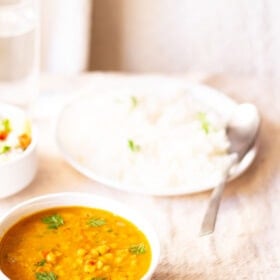
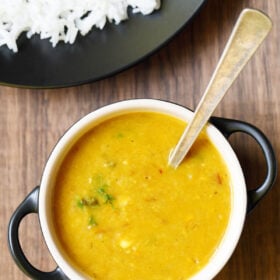
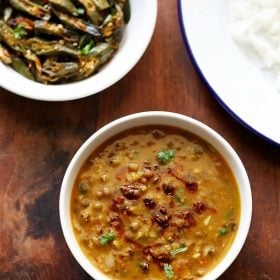
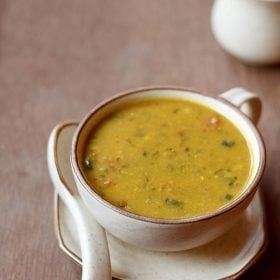
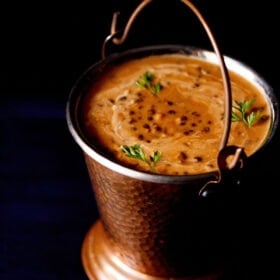
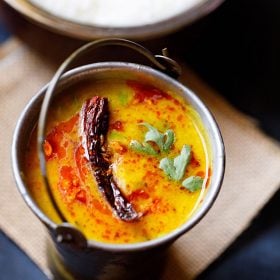
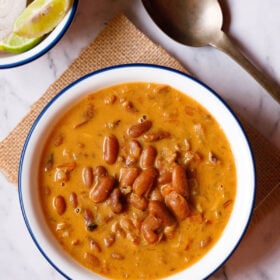
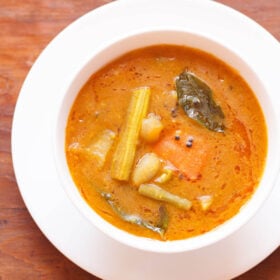








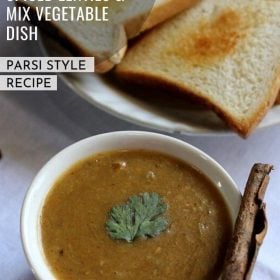
It turned out perfect! I hand blended the veggies after pressure cooking. In love with this dish. Would love to know the nutritional content 🙂
Thanks a lot Janhavi for the feedback and the rating. I will update the recipe with the nutritional data.
Fab recepie…turns out yumm…better than Sodabottle..the parsi chain 🙂
Thank you for the lovely feedback and the rating as well.
This recipe is yummm. Loved it. With the brown rice it became a little heavy maybe coz of the oil. I think the dhansak would taste good even with normal boiled rice. Thank you for sharing a different cuisine recipe.
thanks a lot harry for this lovely feedback. dhansak tastes good even with regular steamed rice.
i tried this today and it turned out awesome.. Thanks for sharing simple and different recipes. It has “hatke” taste, loved it.
Rupali
thanks rupali for this feedback. nice to know.
You have shown tomatoes in the ingredients but not used in the recipe
tomatoes can be added in the recipe. i did not add while taking pics, as i did not have them. i will update in the post more clearly.
Vandana which book is the extracted recipe from dear? Its a bit different form my recipe (doesn’t have elaichis , star anise) and Im keen to experiment with your recipe, thanks!
this is from home science recipe handout from one of my friend. its not from any book.
So how woud you add meat, or like cubed veg? Is this just the sauce base?
shauna, you can cook the cubed veg first and then add them.
Btw it turned out very nice. The tomatoes were not needed. It tastes much like Sambhar. Or maybe I’m confused.
thanks amby. it does not taste like sambar. but it taste good. tomatoes are not essential.
hello, it’s me again. I have been following Tarladalal for a long number of years . I happen to see Vikas kanna showing dhansak with chicken and I searched and found it in your site. So thrilled and the lunch today was this with exactly what you had given with brown rice. It was a real treat without exaggeration. Thank you once again. God bless you. DK
heloo dk ji and thanks again. this dhansak is also our family favorite and i make it on occasions. glad to know you loved the dhansak with brown rice 🙂
What are the tomatoes for? I see them in the list of ingredients but it is not used anywhere..
amby, the tomatoes goes in first step with all chopped veggies and lentils.
Hi Dasanna, tried this recipe and it is simply awesome!! So very nutritious with dal and veggies together. We enjoyed it with plain rice….thanks .
welcome dhanya. glad to know this.
Hi Dassana
i am not a kitchen person . Infarct I dread that area. I along with my daughter had danshak at her teacher’s place. Ever since she has been after my life to give it a shot. That’s how i reached your recipe on the net. Its so wonderfully explained that i find myself tempted to try it. Will sure do and let you know the result.
thanks vandana. go ahead and try this dhansak recipe. its a tried and tested recipe. i am sure, if you follow the steps correctly then the recipe will not disappoint your daughter.
I had tried this recipe out today and the dhansak dhal was excellent.I would like to suggest that everyone use yellow mustard in the dhansak mix.It is imparting a greater depth in flavour.I had served it with sweet rice as suggested by michelin star chef Vikas Khanna but unfortunately it didnt pair well with the dhal.Normal basmati rice goes just fine with it.Thank you so much for sharing these recipes ma’am! 🙂
thanks sanjay. also thanks for sharing the tip on yellow mustard. dhansak goes best with brown rice or steamed rice. it would not go well with sweet rice 🙂
Dear Madam,
You are really great. I am a Keralite brought up in Gujarat. I want to taste something new so I will definitely try this one. Earlier I tried your recipe for Veg Hyderabadi Biriyani. It was perfect. The snaps are very clear and motivating too. Though I use internet since last 10 years I wonder why I did not search for recipes on net. Instead I always preferred cooking shows on TV. Since last three months I am going through your recipes. All these years I was wandering here and there. Now I am settled in Trivandrum (Capital city of Kerala). I am a vegetarian and I alwalys prefer North Indian food when I go out, but here the hotel food (north Indian food ) dont have that taste. I mean here people r good at cooking other stuff. So now I rely on self cooking for all North Indian Food. Thanks for all your effort and All the best.
I even enjoy reading about your college experiences and family preferences. bye
welcome asha and thanks for writing this motivating comment. i loved reading it. actually most hotels are good in cooking the regional cuisine of their state. e.g. in north india, we don’t get good idli and dosa easily.
welcome denisha ji
Thank you Dasanna ji
i m a vegetarian and i was looking for this recipe in the vegetarian version,
your recipe is simple and was looking great.
i m surely gonna try out this recipe
regards
welcome denisha
Here is one dish made from Raw Jackfruit, it is normally made by our Konkani Community. Many more receipies are there. Jacfruit Fritters are even better then the curry, but its a matter of taste. http://www.aayisrecipes.com/side-dishes/raw-jackfruit-in-coconut-lentil-saucekadgi-randayi/
thanks kanchan.
Dear Dassana,
Wonderful recipe and so easy to follow thanks to all the great images!
I am half-Parsi and adore Dhansak daal. In fact, it is often cooked meatless, and non-veg Dhansaak is not auspicious to eat on birthdays and other special occasions, which is when the Parsis usually eat very simple Dhan-Daar (rice and a smooth yellow toor daal with a simple tarkha). Anyway, if you want to learn more about Parsi cooking, I can recommend the truly amazing book “My Bombay Kitchen” by Niloufer Ichaporia King (University of California Press, 2008), it’s not only a beautifully made book, it is really accessible and well-written and researched. You’ll find a number of excellent vegetarian recipes (also non-veg of course) in this book and it’s a real treasure.
glad you liked the recipe anisha. i know through my parsi friends that non veg dhansak is not made on auspicious ocassions. thanks for suggesting the book. i shall be buying it soon.
This recipe turned out great! I have tried many other Dhansaak recipes but nothing turned out as good as this one.
thanks MCN and thats a great compliment for a recipe.
amazing receipe. my wife is still licking her fingers and my kids love it. For them a made a slightly less spicey version. As my wife is from from vizag she has never really been exposed to the food other then south indian. i have one request. some time back when we were newly married my ex boss invited us for dinner at his house. there we had this amazing dish made of kaccha jackfruit chopped into big peices and cooked in some delicious mix of spices. we dont know its name but it was brown in colour and it was a north indian dish (he was from Dehradun). we tried looking up for this receipe for sometime. could you help me with it. thanks again for this great receipe
good to know bhanu that your family liked the dhansak. thanks.
i have never heard about this jackfruit recipe. i will try to find out and if possible will also write about it.
We absolutely love this recipe and have made it several times. Thank you!
one of parsi neighbors used to make chicken dhansak back home.. but its been 15 years since i moved.. thank you for the steps and the masala and the research…. this is going to get made soon! yummmmmmmmmm!
do let me know how the dhansak turns out.
Your receipe snaps looks only yummy with proper measurement of all ingredients step by step dassana, all receipes are simply superb.
thanks neela
This looks lovely. Did you use all the masala paste in the dish?
yes natalie, i used all the masala paste in the recipe.
Just mouthwatering…looks so easy to prepare and delicious!
Thanks a ton. By the way, I AM A PARSI AND A VEG One at that. Now a another request!!!! Could you provide with Dhan Dal and Veg. Patia Recipe. Patia always has fish included in the recipe but I did have Veg. Patia at a restaurant on my way to Navsari. The cook was not available to procure the recipe. So a Parsi Dhandal & Veg. Patia please. Wow this is great.
Mani
dear mani, its rare to be a parsi and a veg. great to know that. all my parsi friends and acquaintances were non vegetarians.
i checked the recipe for dhan dal patia in a cookbook and found out that it has fish. let me see how i can make a dhan dal and veg patia. will surely post the recipe when i make it. i also plan to post some more vegetarian parsi recipes.
That masala paste is gorgeous — I’ll be making some of that.
I will surely try this yum dish
We have to add onions also with all the veggies while boiling?
i have added half of the onion while cooking veggies and the remaining half while sauteing. you can skip adding onion while boiling veggies if you want.